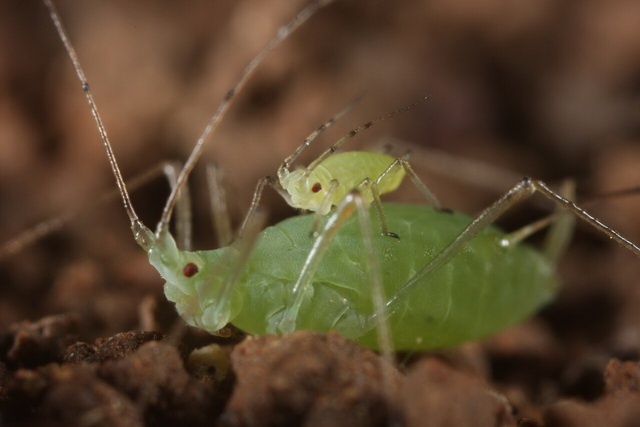Young aphids try to hitch a ride on adults
Young pea aphids demand a piggyback ride on the back of an adult when they have to walk on the soil, Moshe Gish and Moshe Inbar report. But they don’t always get what they want, because the adults try to remove them.
When their host plant starts shaking and a warm, moist air is blowing over it, sap feeding pea aphids (Acyrthosphon pisum) are in danger: a mammalian herbivore is approaching. Just before the plant is eaten by the grazer, they massively drop off the plant to the ground to escape. But they are not safe there either; they can be trampled, dessicate, starve or fall prey to predators that hunt on the ground, like spiders. And so they start walking in search of a new plant.
That is not easy for young aphids (the nymphs). The ground is bumpy with clumps of soil, cracks, stones, fallen twigs and leaves. The young critters are moving much slower than adults. But there is a solution, Moshe Gish and Moshe Inbar discovered: piggybacking on a large aphid.
Tiny drama
In a series of lab experiments, the researchers simulated escape scenes. They placed about ten female aphids on a fava bean plant. Next morning, young aphids had been born; pea aphids can reproduce parthenogenetically, females giving birth to daughters without having been mated. By tapping the plant and exhaling over it, the researchers induced the aphids to drop off. At some distance from the fava bean plant, a circle of lentil plants was placed to offer a destination, the bottom was covered with soil.
A tiny drama takes place in such a case, as the researchers observed. Immediately after landing, young aphids try to climb on an adult. They also climb on green plastic beads and on dead aphids that they happen to stumble upon, but from these, they quickly disembark. If a living aphid stays immobile after they climbed on, they get off after a while too. But when their carrier starts walking, they ride to a new plant, where they arrive faster than when they would have walked the distance on their own.
But adult aphids are not really willing to help young ones.
Nuisance
On the contrary: passengers seem to be a nuisance to them. When a nymph tries to climb on an adult aphid, this aphid will often raise its body to make it difficult, or it runs away. If there are already nymphs on its body, it often stays motionless, waiting until the passengers leave. Or it repeatedly lowers its head or posterior end to the surface to get rid of them. The back is the best place for a nymph to sit on. Eventually, an adult aphid will start walking with one passenger at most.
Once it has left, after a delay, it will reach a new plant as soon as an aphid without a hitchhiker, so the walking speed is not affected by the burden. But it is energetically costly to bear it.
Willy van Strien
Photo: © Stav Talal
Also these tadpoles try to catch a ride
Sources:
Gish, M. & M. Inbar, 2018. Standing on the shoulders of giants: young aphids piggyback on adults when searching for a host plant. Frontiers in Zoology 15: 49. Doi: 10.1186/s12983-018-0292-7
Gish, M., A. Dafni & M. Inbar, 2010. Mammalian herbivore breath alerts aphids to flee host plant. Current Biology 20: R628-R629. Doi: 10.1016/j.cub.2010.06.065
